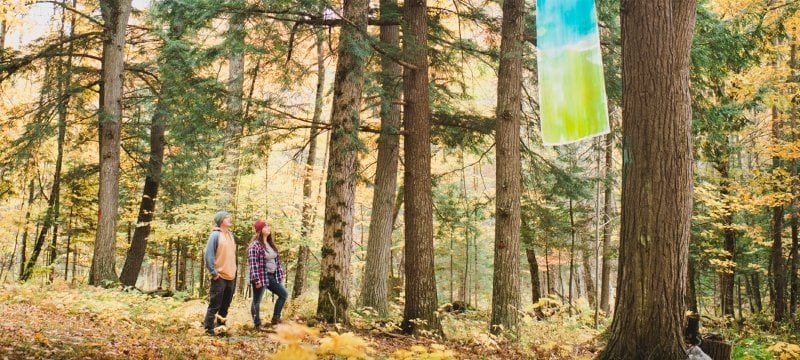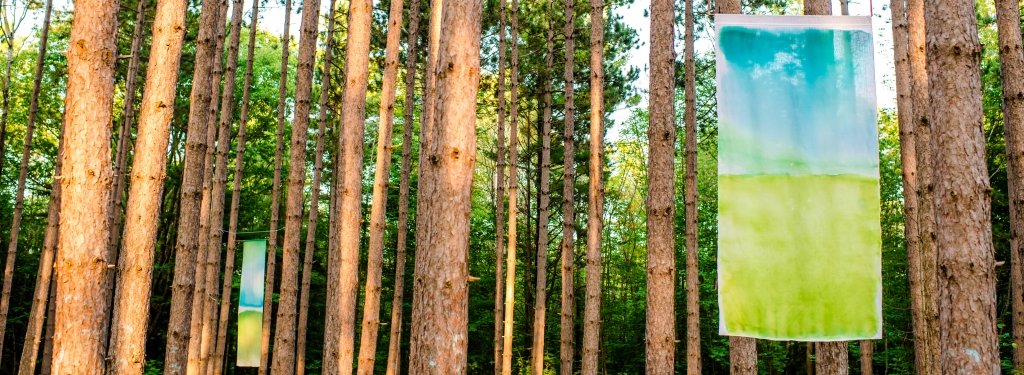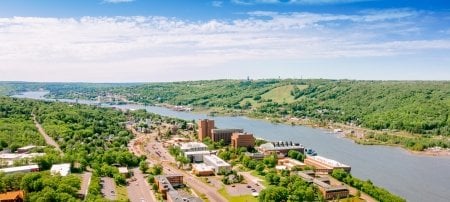Stand. Feel your feet on the earth. Listen. Hear birds call, pine needles drop. Breathe. Inhale and exhale deliberately. See. Choose your focus, with the lens of eyes or camera. Notice how you complete the circuit.
The Contemplative Forest Art Walk at Michigan Tech's Ford Center in Alberta, Michigan, is open to all. But it was created for students. The installation, a series of panels (the largest roughly 10 feet long and 73 inches wide) by public artist and visual arts professor Anne Beffel, is a five-minute walk from the dorm.
"Students can be in the forest in a way that is highly integrative," says Beffel of her latest work, which was created at the invitation of the College of Forest Resources and Environmental Science.
"The project is a collaboration, hand-in-hand with the forest," says Beffel, whose process, often a one-drop-at-a-time medium layering with custom-mixed fabric paints, evokes and complements nature's blue-green horizons. Like science, and meditation, it required patient experimentation. The complex simplicity of an evenly distributed focal point left space for the forest to do its work.
"Putting panels in the forest requires engineering," Beffel says. She tested materials for drape and durability; hemp behaved best in the wind. There are a dozen parts to the copper armature used to hang the works. The design took longer to innovate and build than the paintings themselves.
"They're doing the drawing—the trees, the wind, and the sun."
The walk demonstrates how the well-documented mind-body health benefits of meditation also apply to education.
"Students are learning different ways to notice and choose how they use their minds. That's an invaluable skill," says Beffel. Especially for digital natives, accustomed to staring at screens. The walk challenges the eyes to see in different ways, moving from single-pointed focus to open awareness, consciously regulating what is taken in.
"The banners offer a different kind of screen," says Beffel.

The time-based installation opened in July and remained in place for months. Beffel, who created a similar community-oriented project in Shoreline, Washington, with a circuit installed for nearly a year, views the inevitable weathering process with boundless curiosity and no deadline.
"I'll know when it's time."
Access the meditations.
Meditation Installation
Scaling the heights is nothing new to Jim Schmierer. Before he earned three degrees at Michigan Tech—and began his work as the College Forester 20 years ago, Schmierer spent a decade specializing in commercial, residential, and municipal tree care.
For this project he utilized traditional double-rope technique and climbing saddle to set lines at around 35 feet for a working height of roughly 20-25 feet.
For his safety, he used sectional ladders secured to the trees. For tree safety, he used eye screws and installed the cable between them; the only wound to the tree is a 3/8th-inch drilled hole, and girdling damage is avoided.
"In my eyes, it is interesting that we have a recent timber harvest in a long-term managed area (harvested at least five times prior), as well as two forestry climate change studies and a long term permanent inventory plot all coexisting with an art project in the research forest," Schmierer says. Balancing multiple objectives over the long term and adapting to new uses and projects is being demonstrated."
Michigan Technological University is an R1 public research university founded in 1885 in Houghton, and is home to nearly 7,500 students from more than 60 countries around the world. Consistently ranked among the best universities in the country for return on investment, Michigan's flagship technological university offers more than 185 undergraduate and graduate degree programs in science and technology, engineering, computing, forestry, business, health professions, humanities, mathematics, social sciences, and the arts. The rural campus is situated just miles from Lake Superior in Michigan's Upper Peninsula, offering year-round opportunities for outdoor adventure.





